A geothermal system is basically a heat pump, a type of heating/AC unit common in southern states and hotels. The system transfers heat from where you don't want it to where you do. In the summer, it is an air conditioner. It takes the heat from your house and transfers it outside. In the winter, it is a heater. It takes heat from outdoors and transfers it into your house. Yes, you read that right. Even in the dead of winter, there is plenty of heat to transfer into your house. This is accomplished by increasing and decreasing the pressure of a refrigerant gas in the system by means of a compressor.
The Ideal Gas Law states that if you increase the pressure of a gas, it's temperature will also increase. Consequentially, if you decrease the pressure of a gas, it's temperature will also decrease. Also, if you put a gas under enough pressure, it will turn into a liquid and when you release the pressure, the liquid will turn back into a gas. In the summer, the compressor increases the pressure and temperature of the refrigerant, turns it into a liquid, and sends it to a coil in your duct work. There, the pressure is decreased and the liquid returns to a gas, and the temperature decreases. The coil gets cold and a fan blows the cool air into your house while the refrigerant , which has absorbed heat from your house, returns to the compressor where it dissipates the heat from your house to the air outside via another coil. In the winter, the compressor turns the gas into a liquid, but now it sends it to the outside coil where it turns back into a gas and the temperature decreases. The refrigerant, which is now hot from absorbing heat from outdoors (yes, it really did!,) moves to the coil in your duct work and makes it hot. Your fan blows the warm air into your house.
A geothermal system removes the outside heat transfer coil and replaces it with a coil that is buried deep underground. The ground temperature below 4-5 feet remains relatively constant year round at around 55 degrees. This provides much more efficient heat transfer compared to an above ground coil exposed to constantly changing temperatures. There are some geothermal systems in which the outdoor coils are buried at shallower depths, but use a larger coil to compensate for the warmer ground temperatures. There are other systems that submerge the coil in a pond or an aquifer. Though more difficult to install, they are more efficient as water is such a good conductor of heat. A geothermal system can cut your heating bill 50%-60%, possibly more.
Geothermal misconceptions:
1. You must have duct work in your house for AC. Geothermal AC will not work with any other type of heating system. If you run cold water through baseboard heaters, radiators or radiant heat pipes, you will have condensation on your floors. This would cause wet, slippery floors and water damage to rooms. If you don't have duct work, you can use geothermal for heating only.
2. The heat that goes into your house comes from the compressor, not from the Earth's core. You would have to go down a great depth to reach that heat and if you did, it would be to hot to transfer heat to when you are using AC in the summer. I would also suspect that if you went too deep magma would actually melt the piping!
3. A geothermal system will drastically reduce your fuel cost for the winter, but prepare yourself for a whopper of an electric bill. The spike in your electric bill in the summer when you run your AC will pale in comparison to your winter electric bill. The compressor uses a lot of power and you will be running it all winter long. Do your homework as some compressors are more efficient than others.
Subscribe to:
Post Comments (Atom)

No comments:
Post a Comment